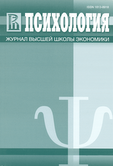The Process of Identification of the Superfluous Condition in Sums by the Second\grade Schoolchildren
Abstract
The article presents a study of the second-grade schoolchildren learning how to solve mathematical problems with text instructions, the kind that they had not had the previous school year. The methodology included a comparison of arithmetical problems of various types (complex and indirect ones) with similar problems containing a superfluous condition (the one that is not necessary for understanding the problem). In some cases the experimenter warned the children that the instruction contained a superfluous condition. The results show that the warning did not have any significant effect on identifying the superfluous condition. Learning to represent a mathematical problem, children learn how to interpret the answer before they can preserve the structure of the problem. They also learn to identify the superfluous condition before they know how to solve such kind of a problem. The study also shows connections between being able to identify the superfluous condition and to preserve the problem structure, on the one hand, and the interpretation of the answer, on the other hand.Downloads
Download data is not yet available.
Published
2011-02-17
How to Cite
КотоваТ. Н. (2011). The Process of Identification of the Superfluous Condition in Sums by the Second\grade Schoolchildren. Psychology. Journal of the Higher School of Economics, 3(2), 111-117. https://doi.org/10.17323/1813-8918-2006-2-111-117
Issue
Section
Work in Progress





